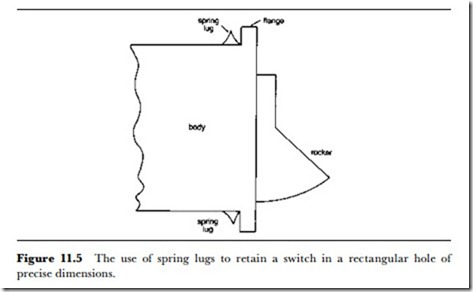Rocker switches
Rocker switches are a more recent development in switch technology. The
aim is to make the switching action easier from the ergonomic point of view: a rocker switch can be operated by a push action as well as by the conventional flicking action, or by any combination of these movements. The rocking actuator of the switch is much more closely coupled to the internal toggling arms, and will snap over at the same rate. For small rocker switches the external rocker is part of the assembly that bears the moving contact(s). The actuating rocker is much wider than the lever of a toggle switch, even a paddle-shaped lever, and results in lower pressure on the operating finger. This extra width requires a broader switch body, so that rocker switches often allow space for signal lights. The considerable differ- ence in the shape of the actuator means that bush mounting is not used, and rocker switches are for the most part fixed by lugs that have a snap action against the mounting panels (Figure ll.5), although a few types use mounting plates that can be bolted into place.
The mechanism of some types of rocker switch can make it possible for the operator to hold the switch in a ‘neutral’ position. If this would be undesirable such switches should not be used, although this does not preclude the use of other designs of rocker switch. The range of electrical and mechanical parameters is much less than for toggle switches, but rocker switches do have particular advantages: they are available in colours to match panel schemes, and can be obtained illuminated. Illumination in non-signal switches generally makes use of a miniature neon with a series resistor of a size suitable for 240 V AC operation (but not suitable for low-voltage use).
